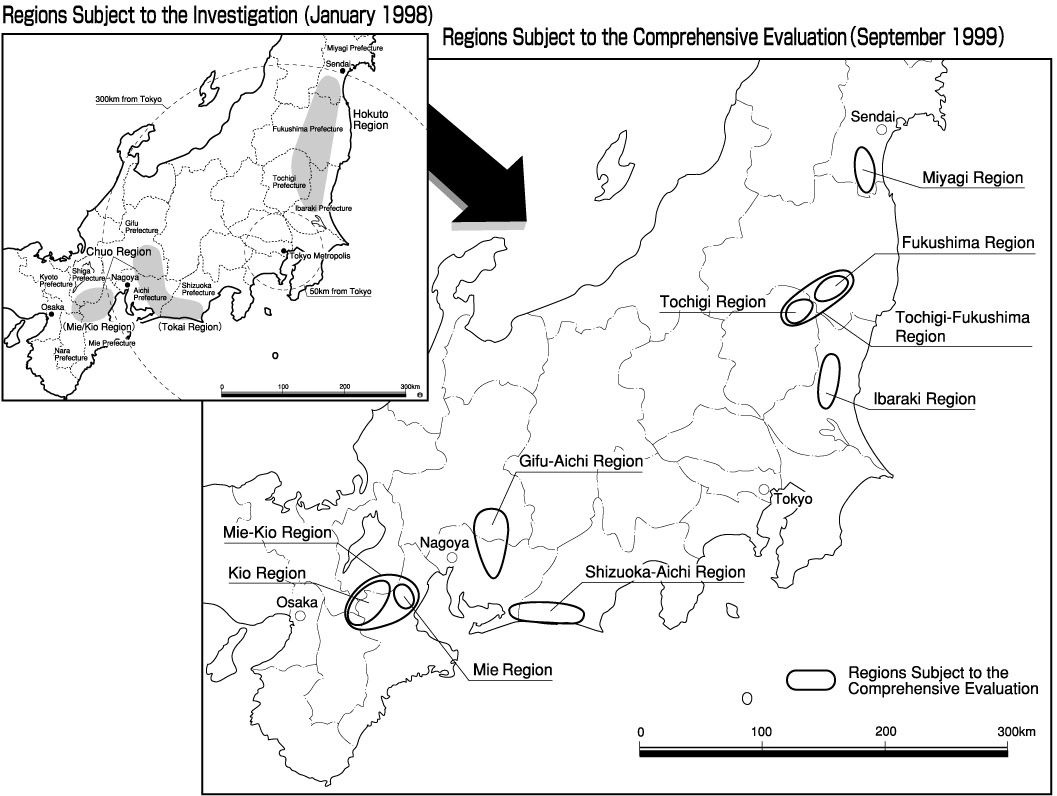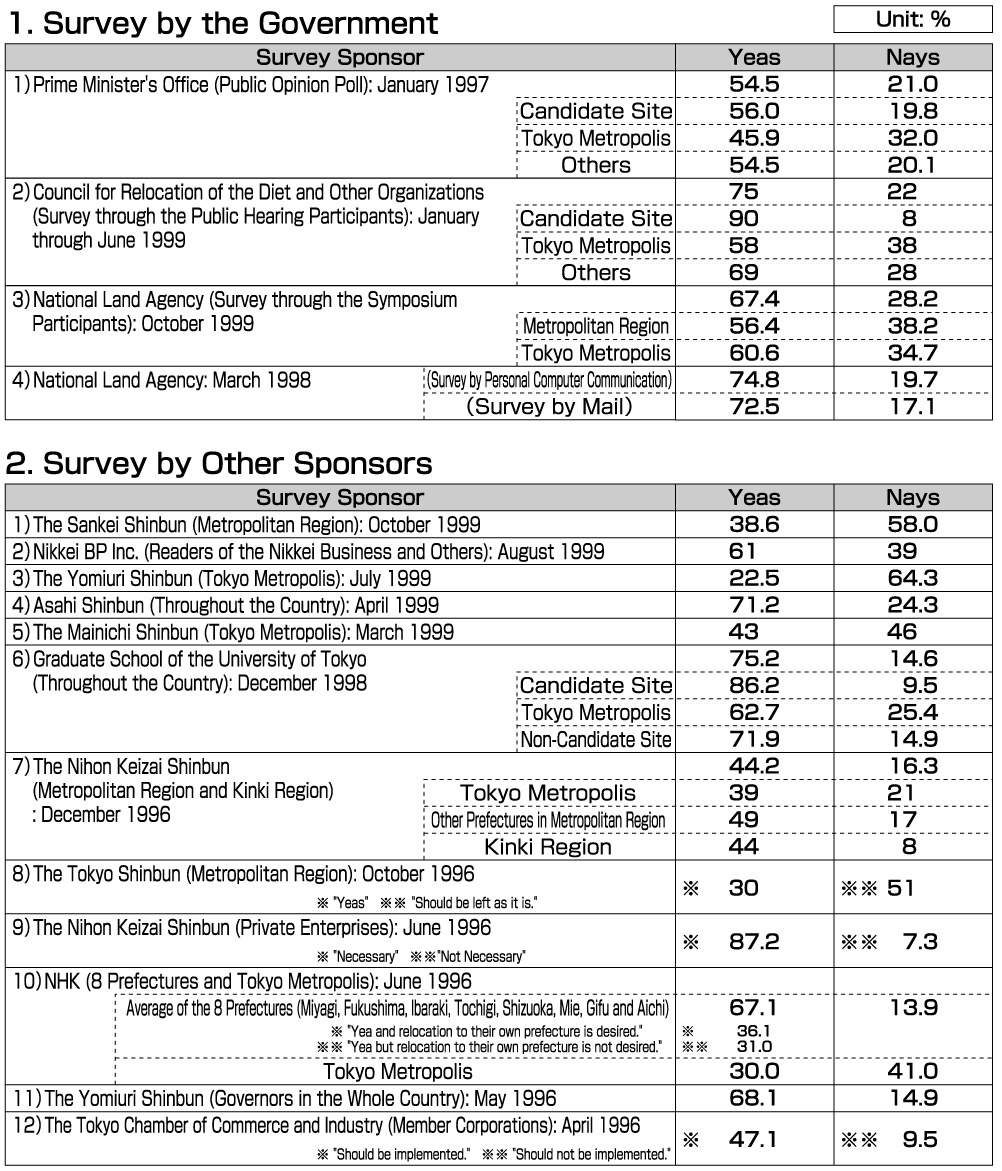Deliberation by the Council for Relocation of the Diet and Other
Organizations Reached Its Final Stage
|
| |
-The Council for Relocation of the Diet and Other Organizations
is comprehensively evaluating each region selected as a candidate
relocation site. The evaluation is based on a mathematical technique
in which experts evaluate each region in terms of 16 items (earthquake,
transportation access, etc.), and each Council member designates
weighting (assignment of differences in importance) to each subject
of the evaluation, and then both evaluations are combined. The Council
established 10 regions subject to the evaluation in September 1999,
including partial duplication, as shown on the map below, from the
regions investigated.
-The Council is selecting candidate relocation sites considering
the results of a comprehensive evaluation based on a mathematical
technique. It is also conducting multi-sided and multifaceted studies
such as appreciating merits and demerits of each region without
adhering to the evaluation results.
-The discussions have now reached their final stage in which the
Council will consider which or how many candidate sites should be
chosen.
|
|
 |
| National
Opinions Concerning Capital Function Relocation |
|
-The Council sorted out trends of national opinions
concerning the capital function relocation. The results of the sorting
out are summarized here.
-The National Land Agency is endeavoring to encourage national discussions
about the capital function relocation through a variety of measures
such as opening the "Opinion Exchange Space" on its Homepage,
and sorting out and releasing typical opinions among those submitted
from the people by E-mail or mail (You can also refer to the National
Land Agency Homepage. (See the note at the end of this leaflet).)
|
| - |
 |
|
|
Major Points Related to Capital Function Relocation (2) |
|
-The Council sorted out main opinions, proposed in
the Council meetings, public hearings, various symposia and by the
mass media, by each point (you can also refer to the National Land
Agency Homepage. (See the note at the end of this leaflet).)
-Part of the opinions are summarized and introduced below, following
those shown in the last issue of the leaflet.
|
|
1.Introduction (Such as Historical View)(Continued)
| Positive
Opinions |
Cautious Opinion |
| The relocation destination will become a city which
symbolizes Japan in the 21st century. |
| Image of city and lifestyle in the 21st century,
such as a city coexisting with the nature and a city
with less environmental load, should have wide appeal
to the world. |
| The role of Tokyo, the conventional capital constructed
as the basis for catching up and surpassing the American
and European cultures, is over. |
| It would be wonderful if we could learn the spirit
of Japan in Kyoto or Nara, realize the history and process
of modernization of Japan in Tokyo, and learn the role
Japan should play in the 21st century for the world
in the new city, the destination of the Relocation. |
|
The concept of the relocation is antiquated and anachronistic.
|
| Geographical significance of the capital decreases
as information network develops. It is anachronistic
to discuss the physical location of the city. |
| Relocation focusing on accomplished facts is an antiquated
concept, and decentralization, control relaxation and
adaptation to the maturity era are urgent issues. |
|
2. Concrete Significance and Effects
-- Strengthening Capabilities to Respond to DisastersPositive Opinions
| Positive Opinions |
Cautious Opinion |
| Risks can be shared by separating the
center of politics and administration from the economic
center. |
| Earthquakes with seismic centers just underneath
the city can occur at any time in Tokyo, and core functions
of the country such as finances, economy and large enterprises
as well as the government would be badly hit if they
occurred. The relocation can avoid simultaneous damage
of the center of politics and administration and the
economic center and thus minimizing serious crisis anticipated
on an international scale. |
| If Tokyo is struck by an earthquake, the new city
will function as the center for emergency control and
restoration to enable rapid rescue activities and disaster
restoration. Emergency control activities can not be
implemented in Tokyo because of the difficulty of collecting
necessary persons. |
| Improved disaster prevention capability in the Tokyo
Region can be expected. |
| Disaster prevention measures are an necessary issue
in Tokyo, but constructing major disaster prevention
structures requires a long time and great expenditure. |
The improved disaster preventing capability in Tokyo
can be improved by utilizing sites left after relocation.
|
|
| Functions should be dualized rather than relocated. |
| What should be done now is to divide the functions.
A system should be established to rapidly deal with
a violent earthquake striking Tokyo. The concept of
relocating capital functions in a single stroke is antiquated.
Dispersion of risks by means of capital development
or capital redundancy and construction of information
backup systems should be given priority. |
| Political functions should be identified with private
functions for security assurance. |
| Kasumigaseki and Nagata-cho are the most earthquake-proof.
Because the area stricken by an earthquake with its
seismic center just beneath the city is within 20 to
30km, emergency measures are possible. |
| The disaster response capability of Tokyo should
be strengthened rather than relocate the capital. |
| Emergency control measures of Tokyo should be implemented
rather than expecting the relocation which might require
tens of years. |
| Priority should be given to constructing a disaster-preventing
city in areas which are very thickly built up with wooden
houses. |
|
|
TOPIC |
"On-line Lecture Meeting" Being Held |
|
--As introduced in the last
issue, lecture meetings are being held on the National Land Agency's
Capital Function Relocation Homepage, and knowledgeable persons
in different disciplines such as academic and economic sectors
are invited to participate. Please visit this web site!
- (Here is where Only Japanese is available)
http://www.mlit.go.jp/kokudokeikaku/iten/onlinelecture/index.html
-Lecturers and themes are as shown below, and several persons
will give lectures every month in the future.
| November |
|
|
Mr. Ken Moroi (Directing Counselor of the
Taiheiyo Cement Co., Ltd.) |
|
Theme: "Relocation on a Small Scale and Rapidly! |
|
|
|
Mr. Haruo Shimada (Professor of the Department
of Economics of the Keio University) |
|
Theme: "To Open a New Era through New City Construction |
|
|
|
Mr. Gregory Clark (President of the Tama
University) |
|
Theme: "Balanced Development and the Capital Functions
Relocation" |
|
|
| December |
|
|
Mr. Takemochi Ishii (Professor Emeritus
of the University of Tokyo) |
|
Theme: "New Capital where Net-generation can Play an
Active Part!" |
|
|
|
Mr. Yoshio Tsukio (Professor of the University
of Tokyo) |
|
Theme: "Capital in the Era of Environment and Information:
Anachronism of Current Discussion" |
|
Main Current Trends
in the Government
|
| - |
Related to the Government |
| - |
| November 26, 1999 |
- |
The 27th Meeting of the Council |
| November 30, 1999 |
- |
The 28th Meeting of the Council |
| December 8, 1999 |
|
The 29th Meeting of the Council |
|
- |
Accessing Various Information |
| - |
-Various information concerning the capital functions relocation
has been being provided on the National Land Agency Homepage on
the Internet.
-Also if you are interested in items described in this leaflet and
others, please let us know. We will pleasingly send related documents
to you. We are awaiting your contact.
|
| We are Waiting for Your
Contact |
| - |
Address: Capital Functions Relocation Planning Division, Metropolitan
Areas Development Bureau, National Land Agency2-2 Kasumigaseki 1-Chome,
Chiyoda-ku, Tokyo 100-9972 JAPAN
Homepage:http://www.mlit.go.jp/kokudokeikaku/iten/index.html
E-mail:hqt-itenka(a)gxb.mlit.go.jp (Please replace (a) with @)
|